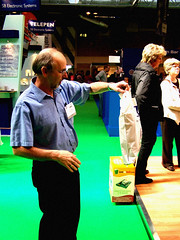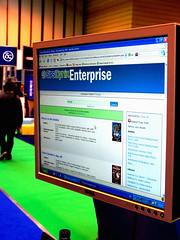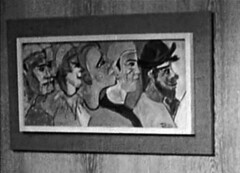It’s not often that I’d consider adding pure “eye candy” to the OPAC, but I couldn’t decide what would be the best way of making this tag cloud functional. So, I made an executive decision and decided it shouldn’t be functional 😀
If you run a keyword search on our OPAC, at the foot of the page you should see a keyword cloud (it might take a few seconds to appear). The cloud is generated from previous keyword searches used on our OPAC. Here’s the one for “library“…

For multi-keyword searches, an electronic coin is tossed and you either get a cloud of the union or the intersection of your keywords. The former uses previous searches that contain any of the keywords, and the later is only those that contain all of them (if that makes sense!)
As it’s not functional, the cloud is just a decorative window into the hive mind of our users.
I’m interested to hear what you think — should the cloud be functional, or does it work as just “eye candy”?
Month: April 2008
Library and Information Show 2008
A big thank you to everyone who came along to my OPAC session at the Library and Information Show last week! If you’re looking for the presentation, it’s available on SlideShare (I’ve finished adding the comments to the slides).
During the afternoon, I snapped a few photographs…







Owen Stephens has already mentioned the funky “Smartblades” from Intellident. I dread to think how much is would cost to kit out an entire library, but maybe in 20 years from now most libraries will have smart shelving? Seeing the blades light up (using blue LEDs) in sequence as they scan the shelves is cool beyond words 🙂
SirsiDynix were demoing an early (“pre alpha”) prototype of “Enterprise” (the replacement for EPS). The search examples shown highlighted that it automatically uses fuzzy searching (e.g. “global warning” also found “global warming”). Over the weekend, I couldn’t resist tweaking the “did you mean” suggestions on our OPAC to do something similar (e.g. “global warning” or “nursing practise“). It’ll be interesting to see what SirsiDynix come up with to differentiate their new product from “Primo” and “Encore”.

RIP: Edward Lorenz
Very sad to see that Edward Lorenz, one of the founding fathers of Chaos Theory, has died.

There can’t be many people who aren’t familiar with the concept expressed in the title of his 1972 paper “Predictability: Does the Flap of a Butterfly’s Wings in Brazil Set Off a Tornado in Texas?”
Lorenz was awarded the Kyoto Prize in 1991 for his work on determinsitic chaos — “a principle which has profoundly influenced a wide range of basic sciences and brought about one of the most dramatic changes in mankind’s view of nature since Sir Isaac Newton.”
Tweet Clouds
I have a confession to make — I grew bored of Twitter after a couple of days.
However, I felt obliged to keep on Twittering something… anything… so I hooked our OPAC into the feed instead. Every 5 minutes, a bit of code checks to see what the most popular keyword(s) used on our OPAC has been recently and, if it’s different to the last run, it fires it off to Twitter. I was so lazy, I didn’t even bother filtering out stopwords.
The result is an eclectic mix of words that encapsulate our student’s usage of the library catalogue — little snapshots of what was important to a bunch of students (or perhaps one particular determined student). Topics meander semi-randomly, occasionally repeating at unusual intervals.
Sometimes, there’s not a single popular keyword, but several. Sometimes the multiple words make sense, other times they create weird phrases…
- british genetics music
- angina attachment theatre
- education picasso sex
- rape skills study
Anyway, a few days ago I spotted Tweet Clouds and decided to see what it made of my feed…

http://www.tweetclouds.com/user_pages/daveyp.html
…and here’s a cloud I made back in December 2006…

I must admit, I feel kinda guilty that I ate up 23 minutes of CPU time on the Tweet Cloud site :-S
Another one bites the dust — RIP SirsiDynix EPS Rooms
Wow — looks like another flagship SirsiDynix product has been shelved. According to reports from attendees at the SuperConference, the company is dropping Stephen Abram‘s beloved EPS Rooms product. Never mind, “shift happens“.
At the conference, the company also announced their version of Primo/Encore (branded “Enterprise”). Curiously, this will be a SaaS only offering. RSS feeds, tagging, user reviews, and ratings are earmarked for version 3 of the product (due around 2010). All I can say is that I’m glad we took the decision to implement these features ourselves, rather than waiting for our vendor to do it for us :-S
Edit — looks like some customers have come away from SuperConference without the foggiest idea of what the product road map is, so I’m happy to wait for clarification from SirsiDynix of their new products, and rumours of EPS’s death have been greatly exaggerated (by me).
Edit #2 — Sorry Stephen, as far as I can tell, it looks like the customer reports were indeed correct. There’s no “end of life” for EPS (in the same way that there’s no “end of life” for Horizon or Dynix Classic) and apologies if the original post implied that there was, but future product development will see the Rooms concept moving into the new Enterprise product.
Calling all Librarians, Calling all Librarians!
Okay — I have a reference question that might just need the awesome combined power of the biblioblogosphere to answer!
A few minutes into the 1960 film “Psycho“, we get to see the following painting hung on the wall of George Lowery’s office…

(click to view larger version)
Firstly, is it a Picasso? If not, is it by a known artist? Can you put a name to the painting?
Other paintings in the film appear to have been chosen for their symbolism, so perhaps this one was too.
If you can answer any of the those questions, please put Joel or myself out of our misery!!!
😀